Master the art of keeping colorful moon cacti with this easy guide for beginning growers!

Moon cacti (Gymnocalycium mihanovichii) are some of the easiest to find and most popular cactus varieties available today. Well known for their funky orb-like shapes and bright orange, pink, yellow, or red coloration, moon cacti can pack a punch into your houseplant collection, but they have slightly different care requirements than most cacti.
If you’ve just picked up a moon cactus, but you aren’t sure how to take care of it, you’ve come to the right spot. This guide has everything you need to know to keep your moon cactus happy for years to come. So follow along with us, and let’s explore this fascinating cactus together!
Jump to:
How to care for your moon cactus
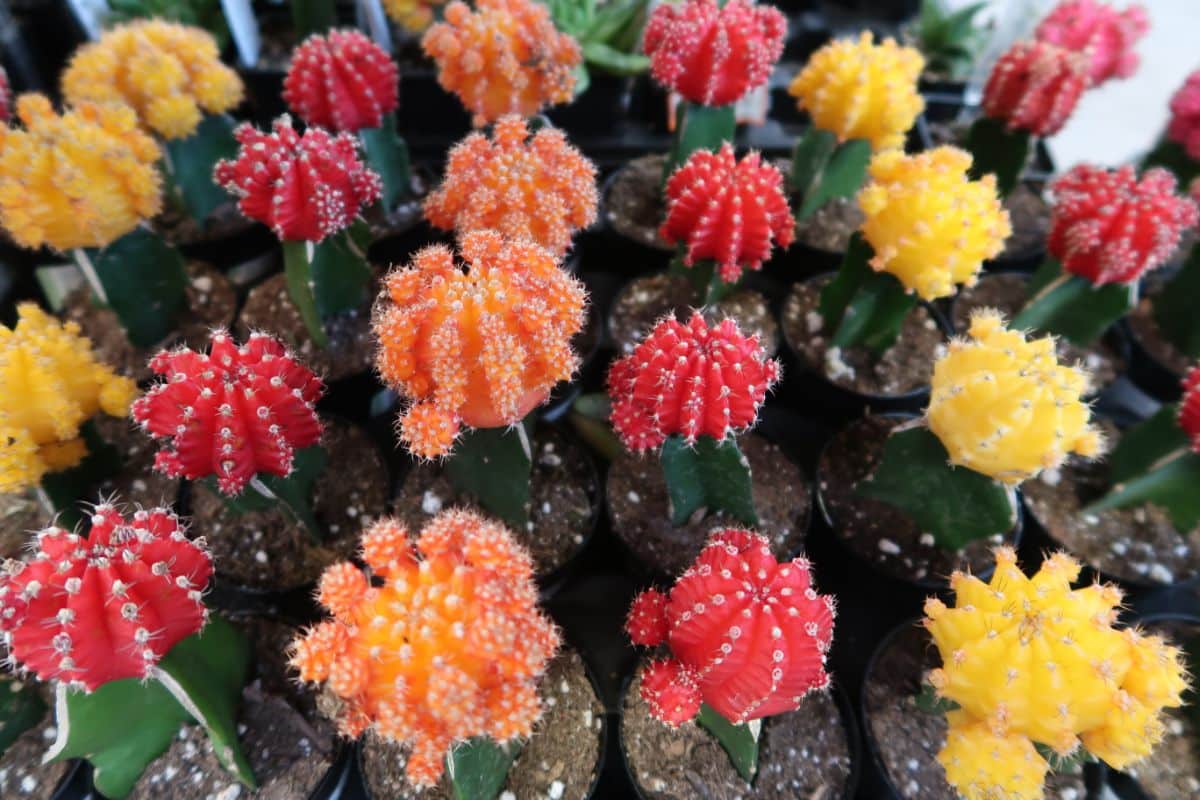
| Plant name: | Moon cactus |
| Scientific name: | Gymnocalycium mihanovichii |
| Other names: | Hibotan cactus, ruby ball cactus, star flowered cactus and red cap cactus |
| Native range: | Brazil, Paraguay and Argentina |
| Growing zone: | Zones 11 to 12 |
| Light requirements: | Bright, indirect light |
| Water requirements: | Low |
| Size: | Up to 12” high |
| Color: | Red, orange, pink and yellow; green stem |
| Toxic? | No |
Moon cacti are native to the deserts of South America, including locations in Brazil, Paraguay, and Argentina. Wild moon cacti are bulbous in form and green, and you won’t find any of the colorful moon cacti you see at plant nurseries out in nature. That’s because those vibrant pink, orange, yellow, and red moon cacti you can buy are mutant plants that can’t survive on their own in the wild.
These mutant moon cacti are so colorful because they are lacking in chlorophyll, which allows their wild counterparts to photosynthesize. Without chlorophyll, colorful moon cacti will die, so plant scientists and nursery workers graft moon cacti onto another cactus variety that forms the “stem” of storebought moon cacti. Most often, dragon fruit cacti (Hylocereus undatus) are used for this job, and these cacti are able to photosynthesize for both themselves and the moon cactus they’re grafted onto.
Because moon cacti are manmade, they do have slightly different needs than most other cacti. They also generally don’t live as long, as the two cactus species grow at different rates and may break apart. A well-maintained moon cactus will usually live for about 1 to 3 years, although you may be able to keep yours growing longer if you regraft it onto another section of dragon fruit as it matures.
Growth habit
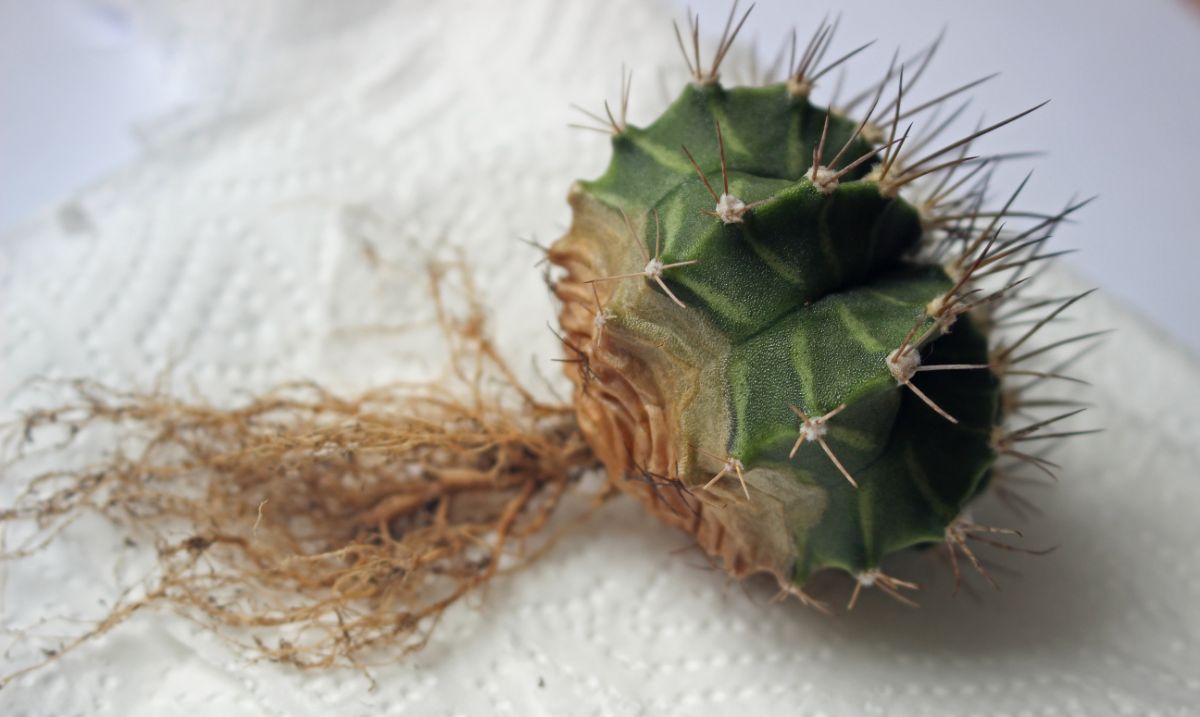
Wild moon cactuses grow in ball-like shapes that are heavily ridged with deep grooves. The cactus’ green flesh is accented by small, white spines that are quite sharp. When fully mature, these cacti can grow to about 8” in diameter.
Manmade, grafted moon cacti are oddball plants with a very unique shape compared to other cactus varieties. The colorful, orb-like moon cactus is perched atop a slender, spineless stem that is usually harvested from a dragon fruit cactus. Depending on the base cactus, these plants grow to about 12” high.
Light
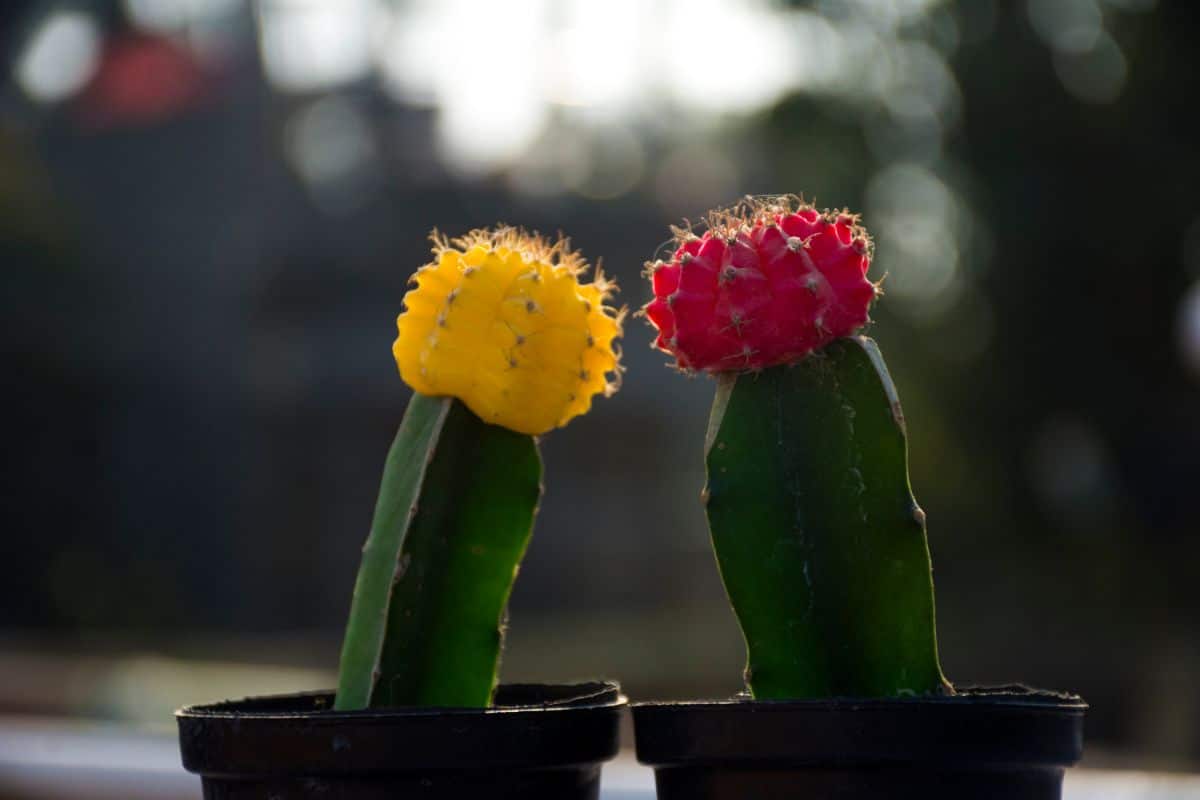
Cacti are well-known as plants that thrive in intense, bright light. But moon cacti are a bit different since they naturally lack chlorophyll. In fact, these plants can easily develop sunburn if they are kept in full sun.
Instead, moon cacti should be provided with lots of bright, indirect light. If your windowsill is too bright, move your cacti a few feet away or add a sheer curtain to filter some of the light and reduce the chances of sun damage.
Water
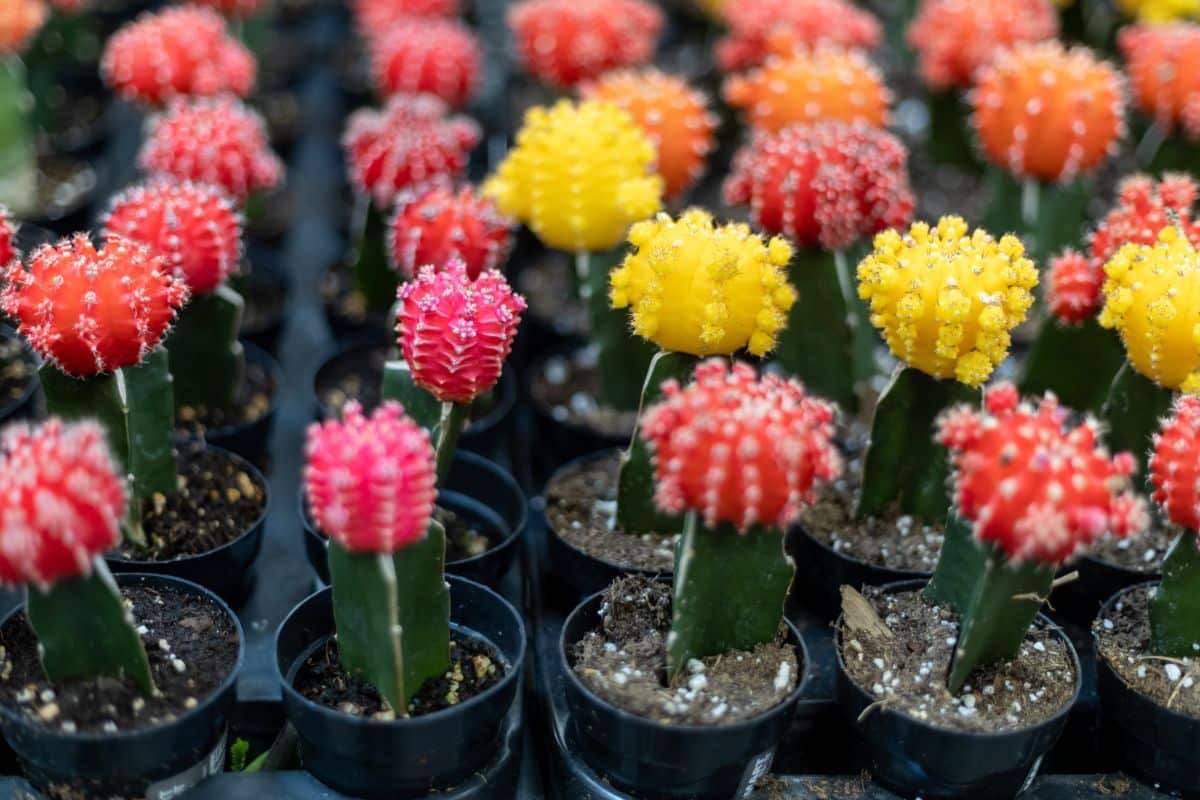
Like other cacti, moon cactus plants don’t need a lot of water, and they can be very susceptible to rot if they are kept in damp conditions.
These plants do best when they are watered deeply, and then the water is allowed to fully drain out of the plant’s pot. After that, allow the plant’s soil to dry out completely, and then wait at least another week before watering your moon cactus.
During the growing season, moon cacti should be watered every few weeks or even less. These plants shouldn’t be watered at all during the winter.
Temperature and humidity
Moon cacti do well at average room temperature, but they cannot handle frost, and they will die if they’re exposed to cold. These plants should also be protected from drafty windows, which can also cause tissue damage and discoloration.
Like other cacti, moon cactus plants have low humidity needs and can handle average indoor humidity levels.
Soil and repotting
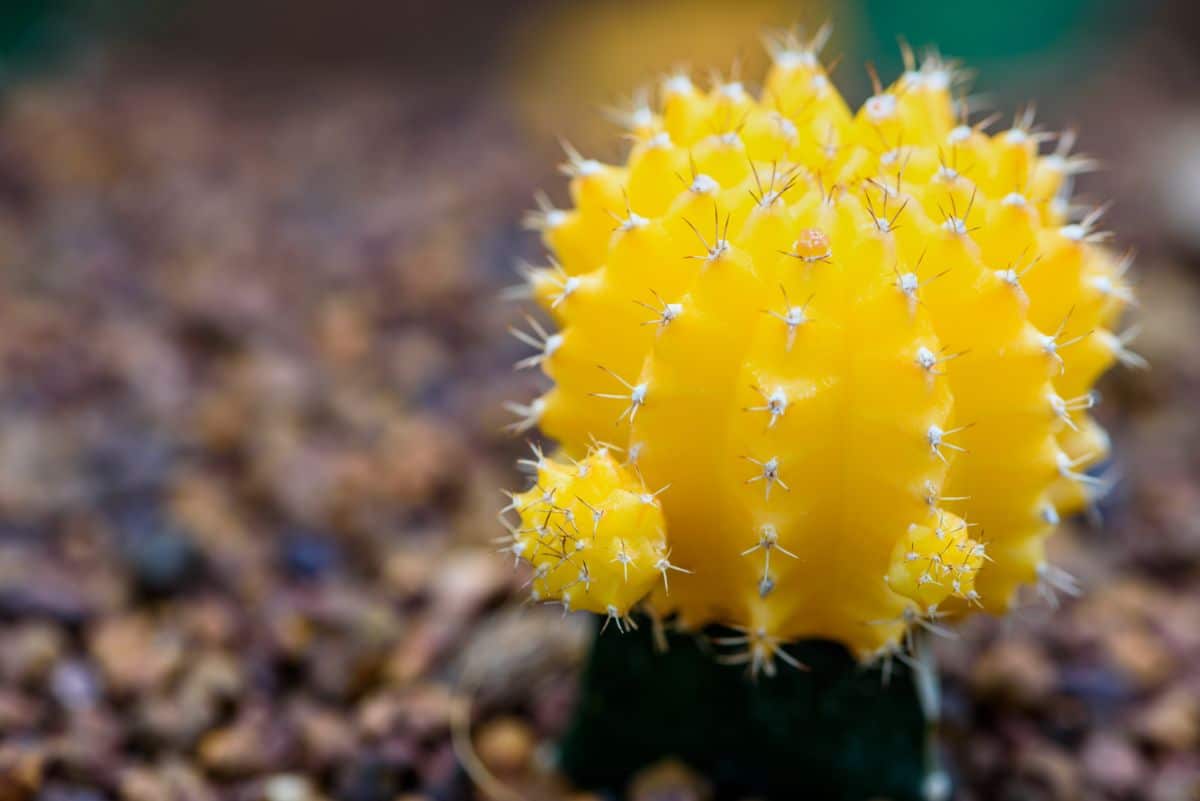
Moon cacti are slow-growing plants, and they usually don’t live very long, so they don’t often need to be repotted. However, you may want to repot your moon cactus after about 3 to 4 years to freshen up the soil and help your cactus grow a bit better.
When repotting your moon cactus, repot it in the same container or opt for a pot that is just slightly larger than your original pot. Use a well-draining potting mix intended for cacti and succulents.
Fertilizer
Moon cacti are slow-growing plants, and they don’t need a lot of fertilizer. But if you want to give them an extra nutrient boost, try fertilizing your plant about once a month during the growing season. For best results, use a fertilizer that is specifically formulated for cacti.
Regrafting your moon cactus
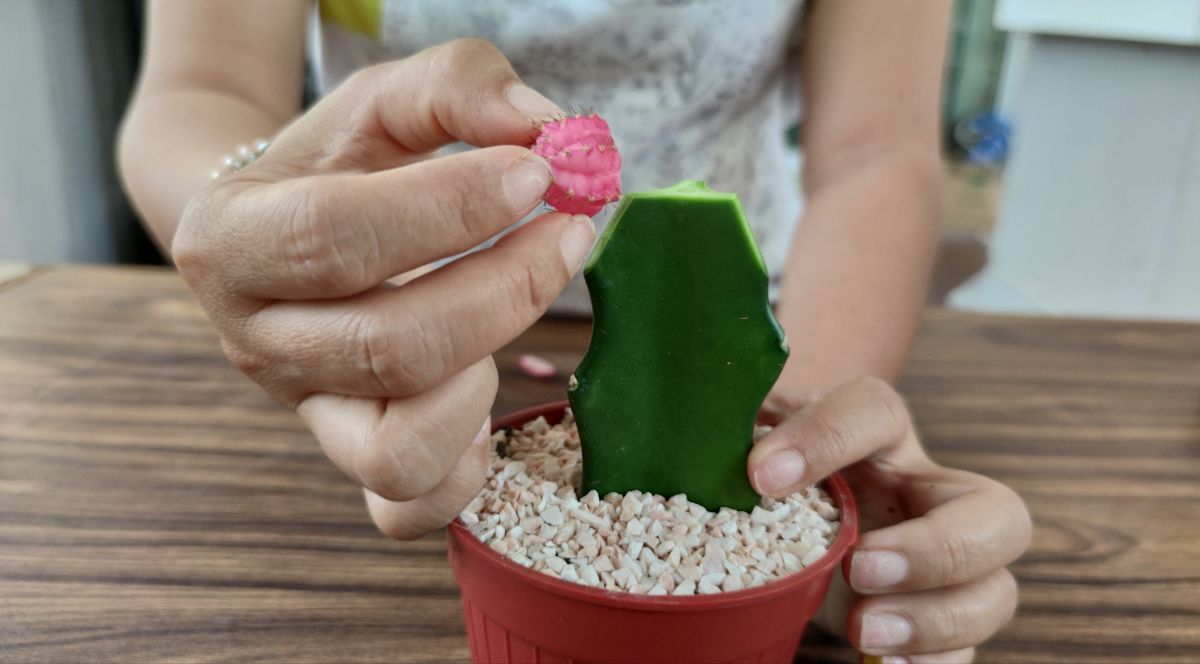
If you notice that your moon cactus is breaking away from its dragon fruit stalk or the two cactus sections are growing at different rates, you may want to regraft your cactus. This will help improve the look of your moon cactus and extend the life of your plant too!
Regrafting may sound tricky, but there’s not much to it.
Using gloves, take a sterilized knife and gently cut the moon cactus away from its supportive stem. If you’re going to reuse the dragon fruit stem, cut the top of the stem off to make a fresh area for grafting. If your dragon fruit stem is damaged, you may want to use a new section of dragon fruit stem and cut the top of that off so it can be grafted onto your existing moon cactus.
After making your sterilized cuts, place the cut side of your moon cactus on top of the cut section of the dragon fruit stem. The two plant sections should be roughly the same size but try to line them up so as much of their flesh is touching as possible.
Then, secure the moon cactus to its new stem with rubber bands or twine and leave the pieces in place for several weeks in a spot that receives bright, indirect light. After about 2 weeks, your plant sections should be grafted together, but you’ll want to handle them with care for a bit longer, so you don’t accidentally jostle them free.
Now, step back and give yourself a pat on the back. You just grafted a cactus!
Toxicity
As with most other cacti, moon cacti are non-toxic to pets. However, since they have spines, you’ll still want to locate them in a place where your pets won’t accidentally get prickled by your cactus!
Moon cactus propagation
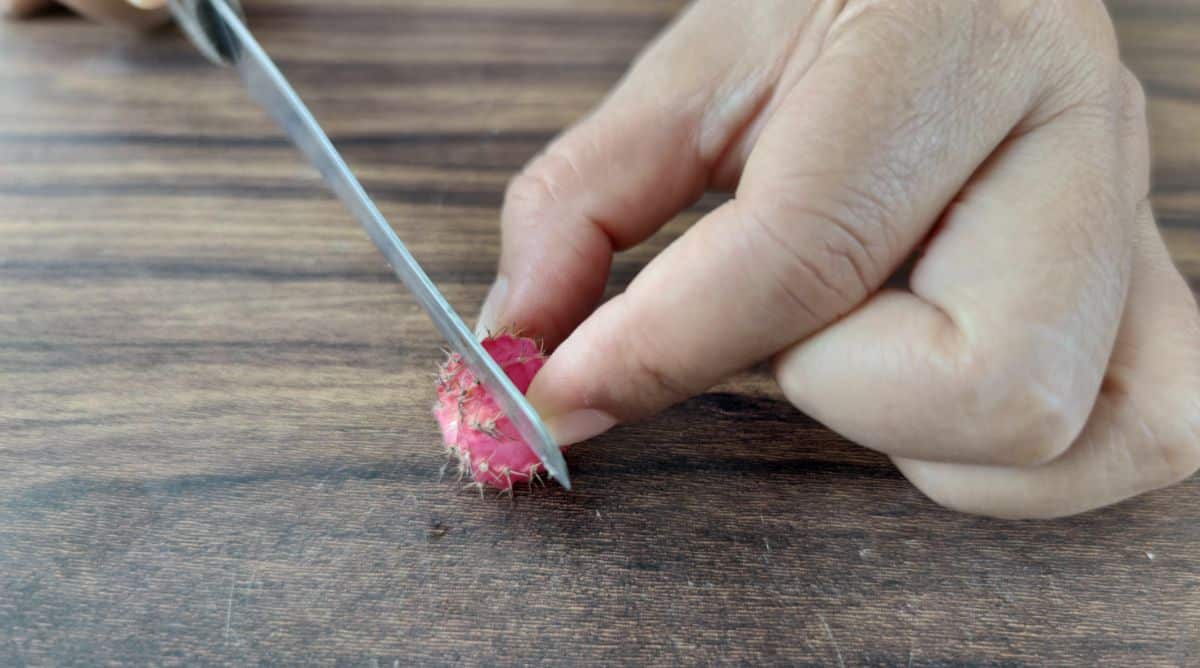
Because moon cacti are manmade creations, they won’t naturally propagate on their own. But you can make new moon cacti with offsets from your original plant.
First, you’ll need to create a rooted cutting of a section of dragon fruit stem or other cactus specimen that will graft well with your moon cactus.
After that, it’s time to separate your moon cactus pups or offsets from the parent plant. Check the pups over carefully and select the ones that look the most healthy, as weak and underdeveloped pups won’t propagate well. Healthy pups should be plump and vividly colored without any signs of obvious damage.
Using gloves, grasp ahold of the pup and the parent plant and wiggle them apart. You’ll want to be gentle with this to avoid damaging either plant.
Once your pup is separated, cut off the underside of the pup with a sterilized knife, and then cut off the top of your dragon fruit stem. Sterilize your knife with rubbing alcohol before you get started to avoid accidentally contaminating your plant sections.
Then, place your moon cactus pup on top of your dragon fruit stem and secure it in place with a rubber band or twine. Make sure that the two sections of cacti are about the same size and that the cut sections of tissue are touching. The two sections should be grafted together within about 2 weeks.
Common issues
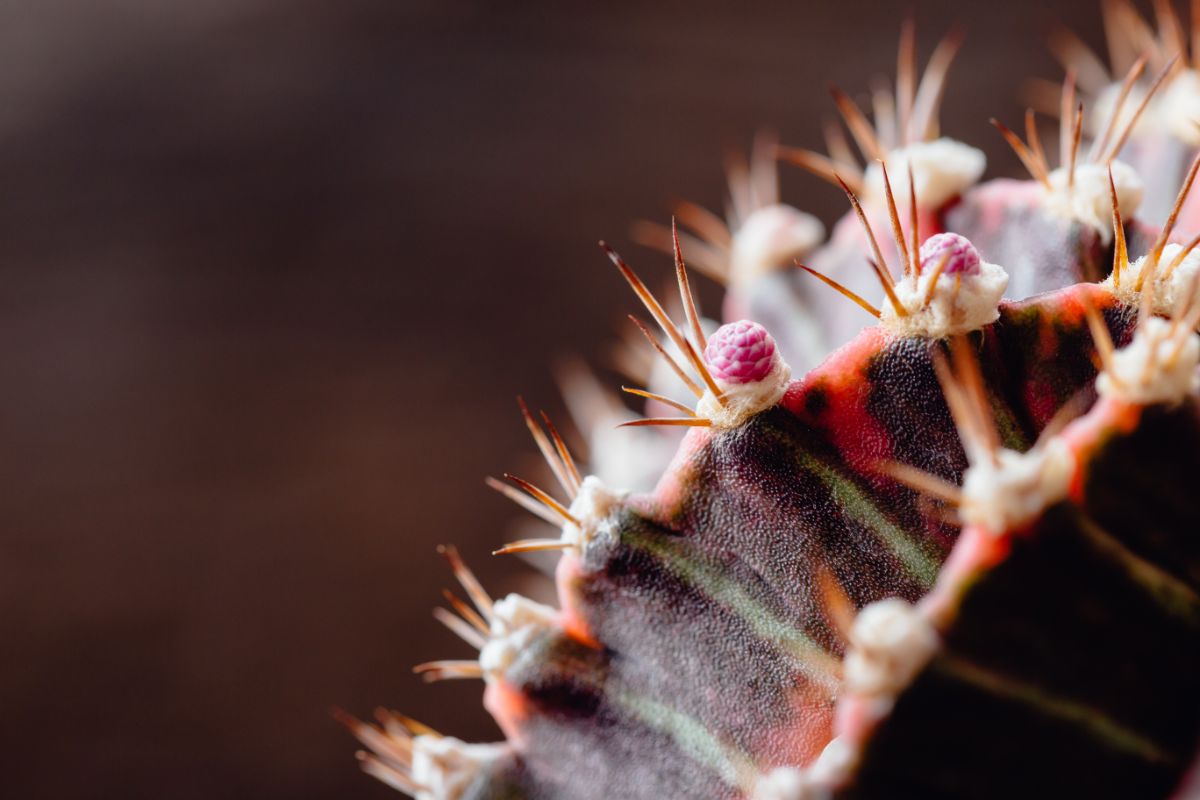
Moon cactus plants are pretty hardy, but they are susceptible to a few issues. Below are the most common problems you may encounter when keeping these plants and what to do about them.
Overwatering
Overwatering is very common with houseplants and can be particularly problematic with cacti since they have lowering watering needs. Moon cacti that have been overwatered will typically develop dark spots that may be soft to the touch. If the rot progresses, your cactus may become very mushy and will collapse.
Once overwatering occurs, it is difficult to treat, but you may be able to stop the damage by cutting back on watering significantly and allowing your soil to dry out completely before you water your plant again. Most of the time, however, if your cactus has been overwatered and rot has developed, the easiest thing to do is to compost your plant and start over with a new moon cactus.
Sunburn
Moon cacti don’t have chlorophyll, so they are more susceptible to sun damage than most other cactuses. If this occurs, you’ll notice discoloration or brown spots developing on your plant on the side of the cactus that is facing the light source.
You won’t be able to fix existing sun damage, but you can prevent more from occurring by moving your cactus away to a location with more filtered lighting.
Spider mites
Spider mites are common indoor pests that feed on plant sap and can weaken and kill plants over time. Affected plants often have a dull and dry appearance, making them look like they’re underwatered. But, upon closer inspection, you may notice that your plant is covered in fine, spider-like webbing, and you may even see tiny mites running around.
Spraying your moon cactus with neem oil or organic insecticidal soap sprays should remove these troublesome pests. Just be sure to only apply these sprays in the evening after the sun sets and repeat the spray several times at weekly intervals.
Scale and mealybugs
Mealybugs are a variety of soft-bodied scales that look like white, cottony patches on your plant. Hard-bodied scales have dense exoskeletons that are brown and domed. These insects don’t move very far, so they are easier to treat than some other pests, but they can weaken your moon cactus by feeding on its sap.
Treatment for scale insects is the same as treatment for spider mites. Organic insecticidal soap or neem oil sprays are effective, but they should be applied several times.
Similar plants
If you like the look of moon cacti but you want to expand your collection with other colorful and easy-care plants, here are some other top houseplants to try.
Coral cactus
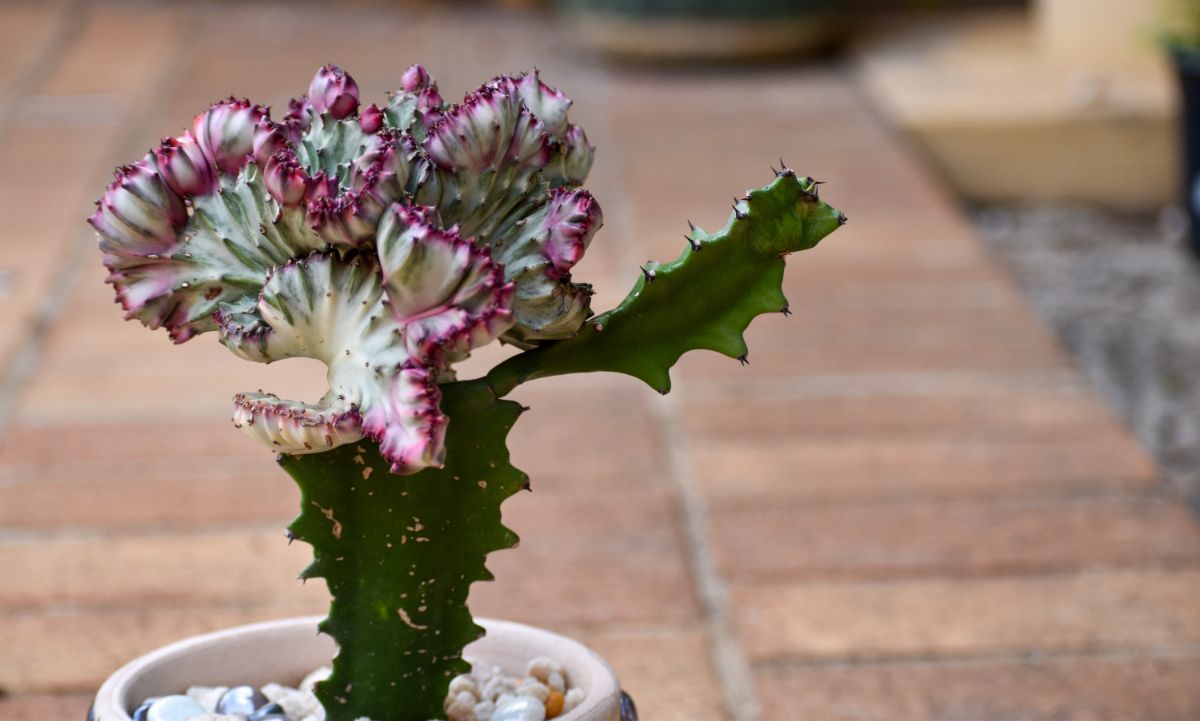
The coral cactus is another intriguing, Frankenstein-like plant that is also created by grafting two different plants together to create a new specimen. In the case of the coral cactus, two varieties of Euphorbia are grafted together to produce a plant with an oversized, ruffly top and a slender stem. Like the moon cactus, the coral cactus is a low-maintenance plant with minimal watering needs.
‘Widow’s Thrill’ Kalanchoe
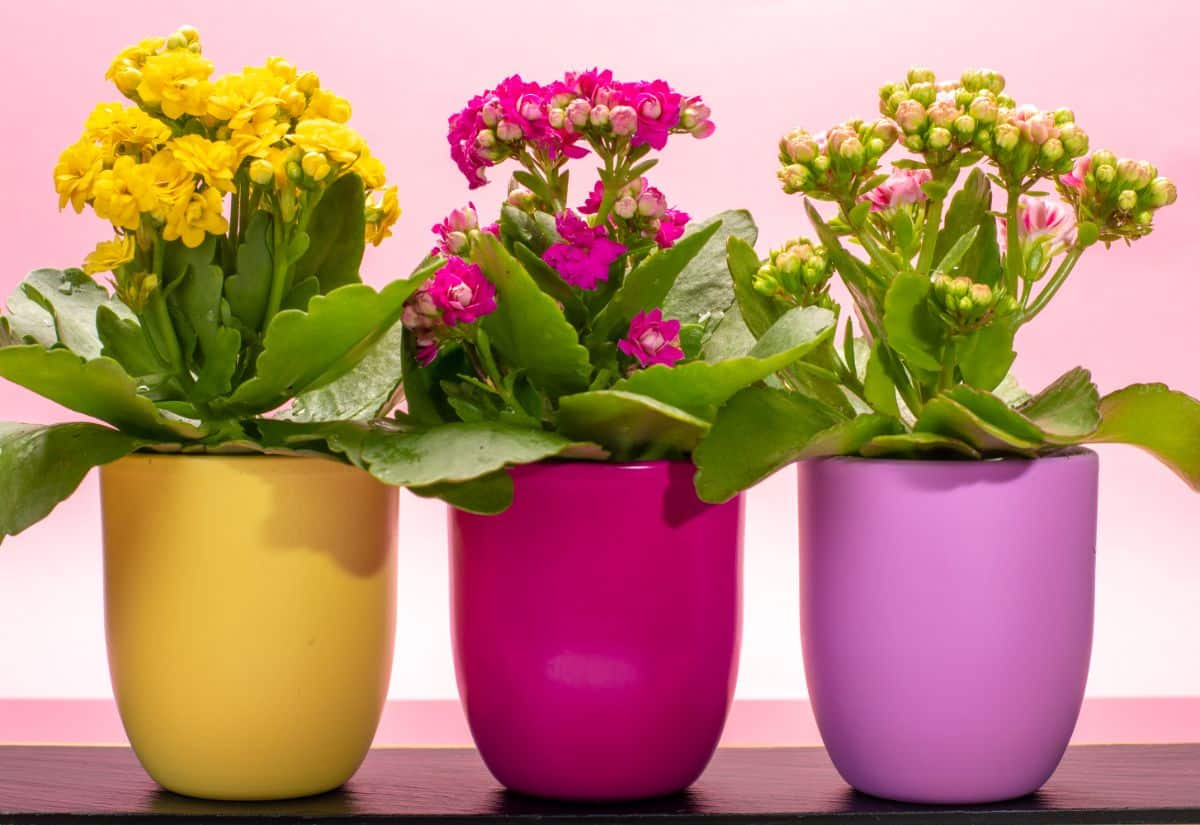
If you’re drawn to the colorful variety of moon cacti, you’ll love ‘Widow’s Thrill’ kalanchoes too! These succulent plants have classically green leaves, but they come alive when they bloom. Flowers come in almost the same shades as moon cacti (red, orange, pink, and yellow), so these plants display beautifully together.
Golden barrel cactus
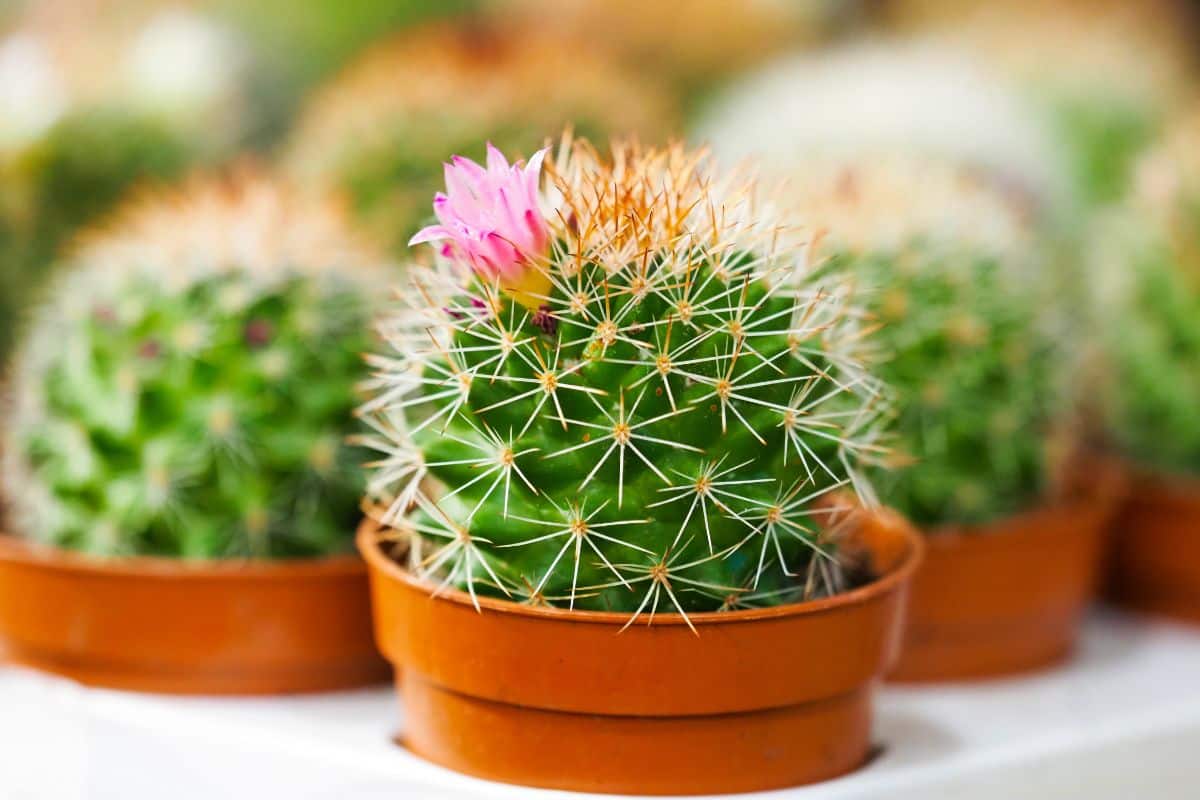
Golden barrel cactus is a traditional cactus choice that is very easy to care for. Like moon cacti, this cactus has a ball-like shape, but it is even more low maintenance than moon cacti since it isn’t a hybrid plant. Golden barrel cacti also have a lovely pop of color in the form of their vivid, golden spines.
Frequently asked questions
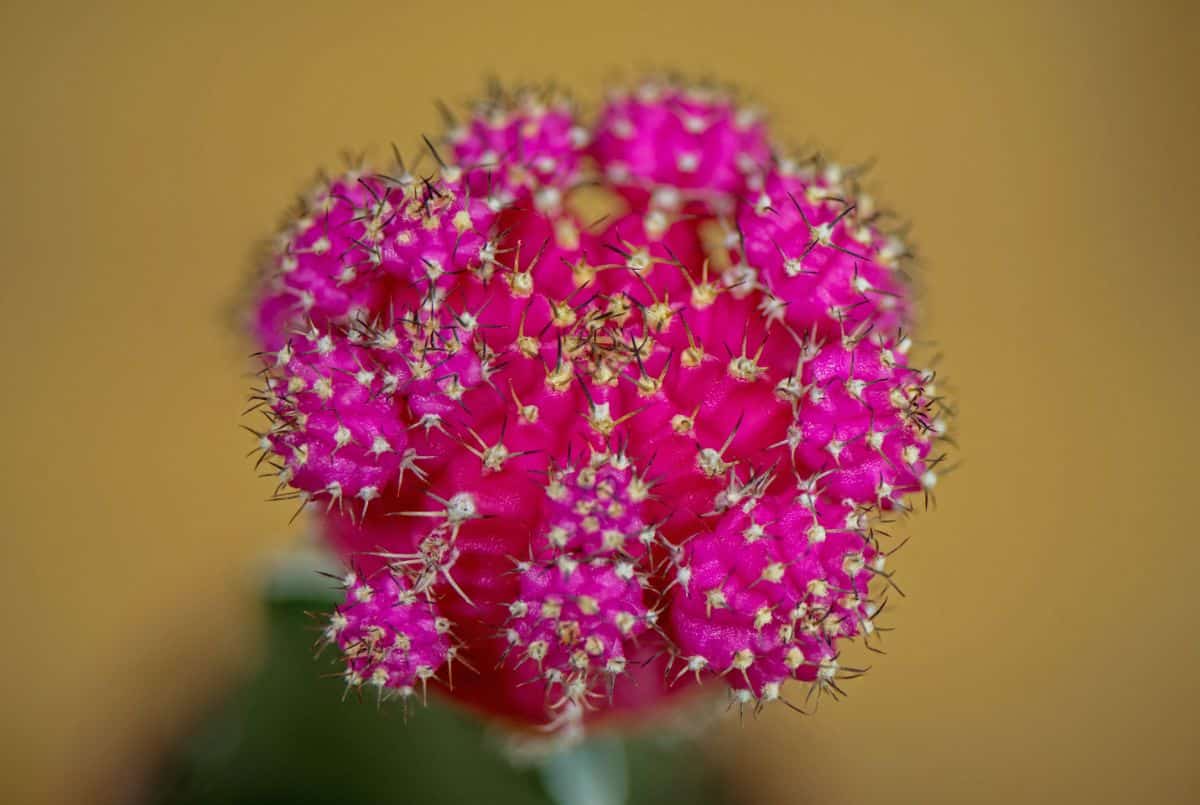
Moon cacti don’t need to be watered much and should only be watered about once every 3 to 4 weeks (or even less) during the growing season. Watering should be further reduced during fall and winter when this cactus isn’t actively growing.
The most common reason moon cacti die is due to watering issues. Be sure not to overwater your plant. If in doubt, water less than you think you need, as underwatering is much easier to fix than overwatering.
Removing the pups from your moon cactus can extend the life of your plant and also provide you with lots of new cacti to enjoy. The more pups your cactus produces, the faster it will deplete the dragon fruit stem that is supporting the moon cactus itself. Over time, moon cactus pups can slow down the growth rate of the parent plant and shorten its lifespan.
Even though moon cacti don’t love the bright sun, they do like a lot of indirect light. Cactuses that start to lean often do so because they are stretching towards the light. To prevent this, make sure your cactus is getting enough light and turn your pot every 2 weeks or so to keep your plant growing straight.
Overwatering is very common with moon cactuses and will result in dark, mushy spots on your plant. If the damage is very severe, your plant may turn soft and collapse on itself.
Most commonly, moon cacti are grafted on dragon fruit cactus sections. These cacti are often frequently grafted onto Peruvian apple cacti (Cereus peruvianus) and golden torch cacti (Trichocereus spachianus) as well.
Summary
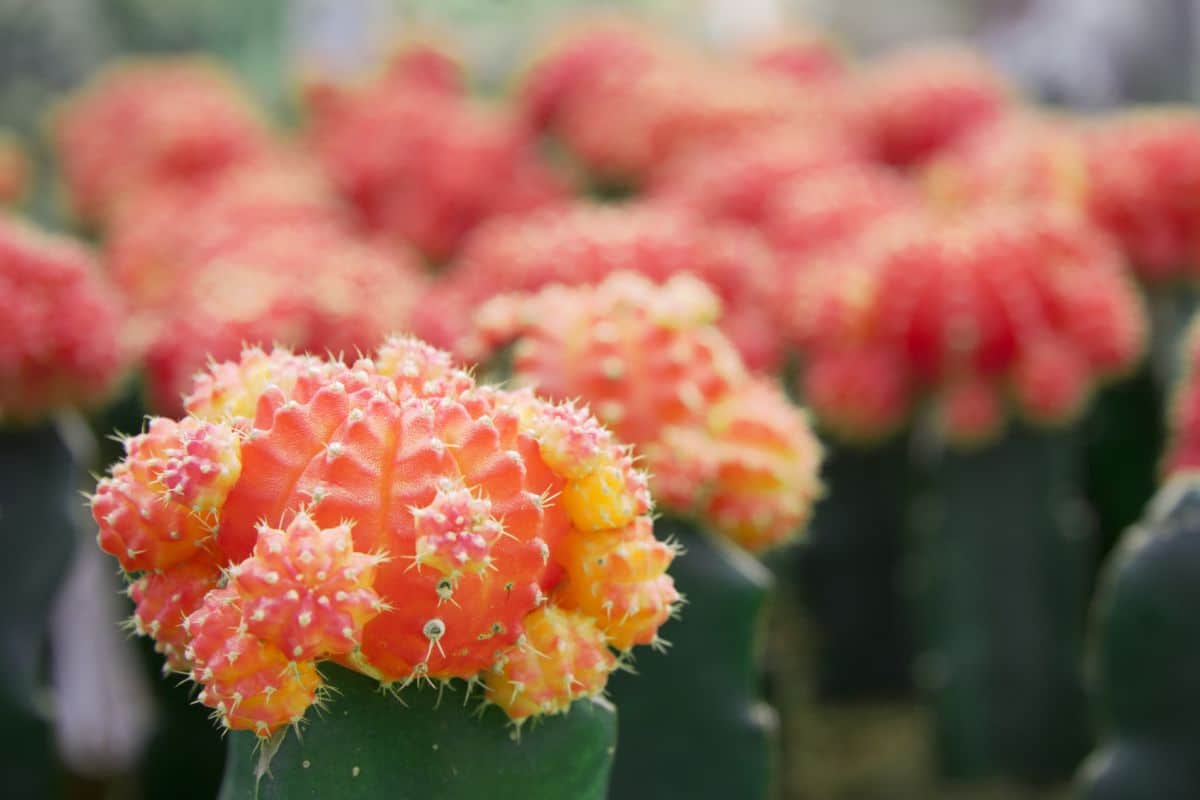
Moon cacti are popular in the houseplant trade for a wide variety of reasons. These colorful and curious-looking plants are hits with kids and add vibrancy to houseplant shelves, but they are also super easy to care for and beginner friendly. What’s more, they can provide you with a learning opportunity to master grafting and learn more about plant biology thanks to their unique growth.
Caring for moon cacti isn’t complicated; you just need to figure out the right amount of light and water for your plant. Once you’ve mastered that, your moon cactus should grow happily for years. And if the moon cactus inspires you to fall in love with cacti in general, there are lots of other low-maintenance cactus plants you can try next!

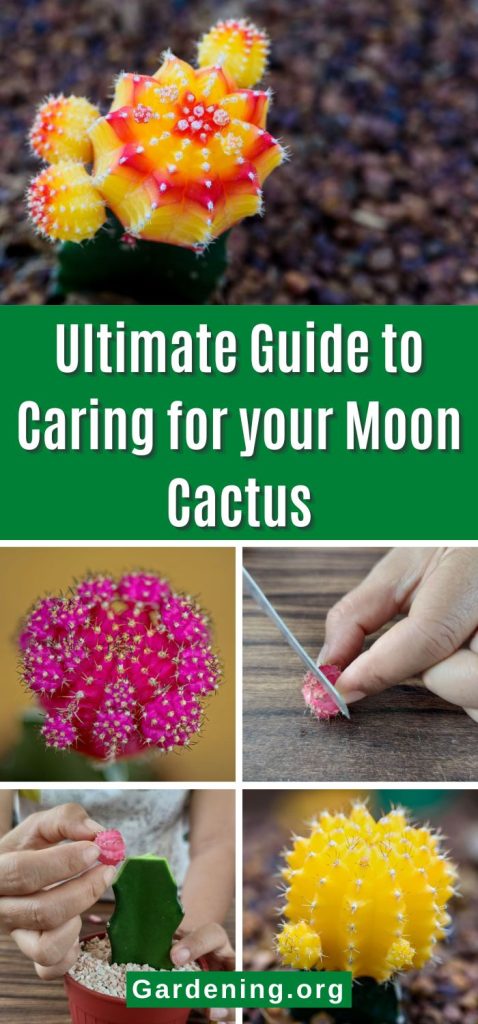
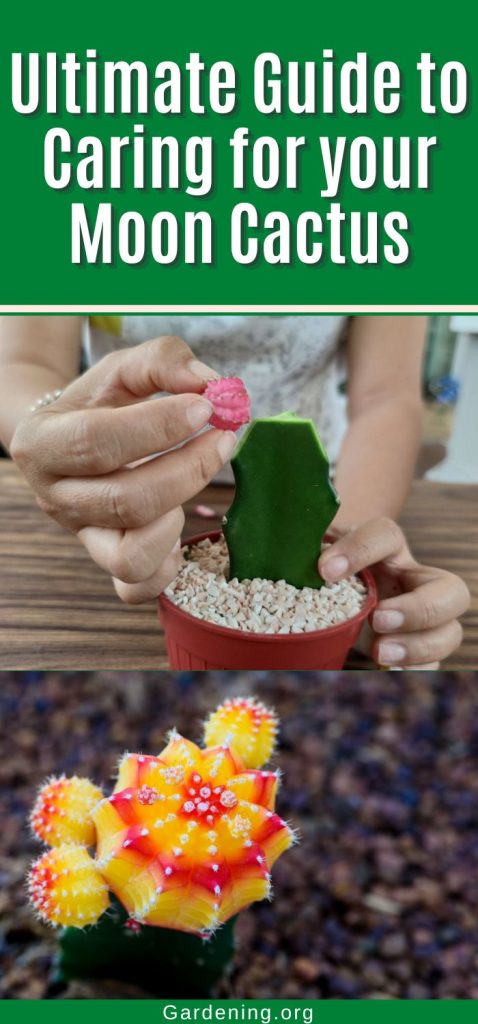
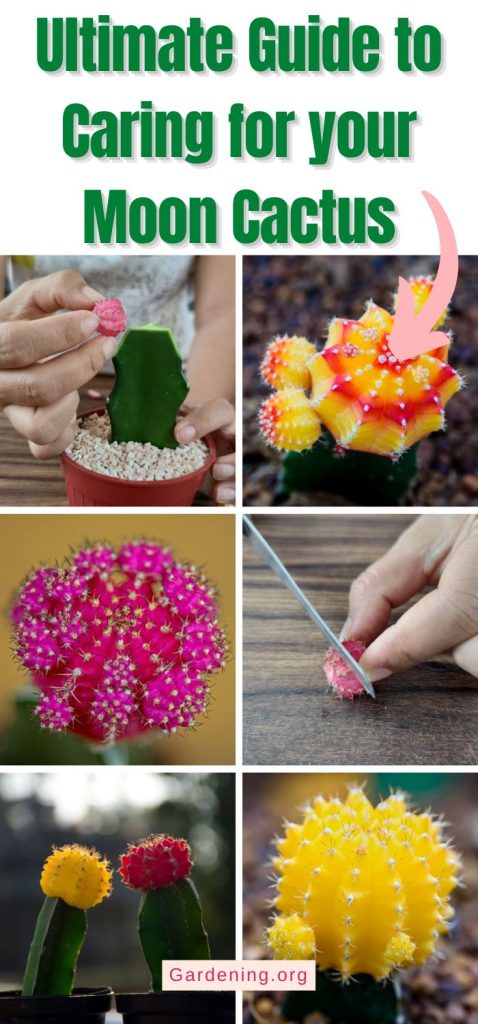

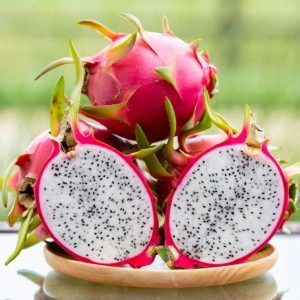
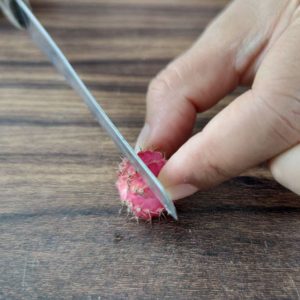
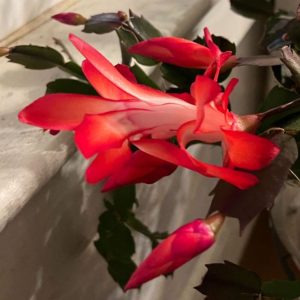
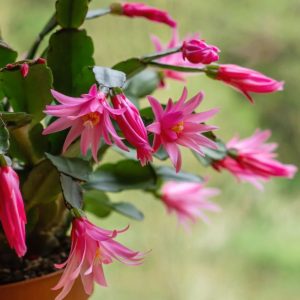
Leave a Reply